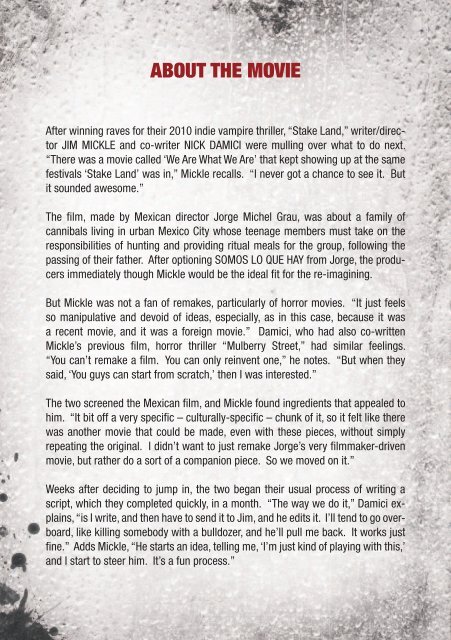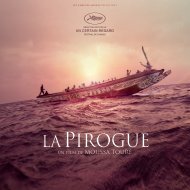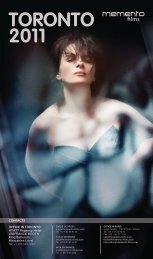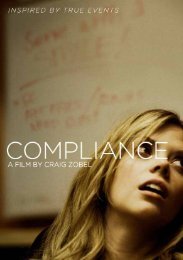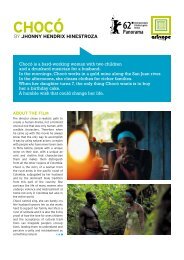Press Kit - Memento Films International
Press Kit - Memento Films International
Press Kit - Memento Films International
You also want an ePaper? Increase the reach of your titles
YUMPU automatically turns print PDFs into web optimized ePapers that Google loves.
about the movie<br />
After winning raves for their 2010 indie vampire thriller, “Stake Land,” writer/director<br />
JIM MICKLE and co-writer NICK DAMICI were mulling over what to do next.<br />
“There was a movie called ‘We Are What We Are’ that kept showing up at the same<br />
festivals ‘Stake Land’ was in,” Mickle recalls. “I never got a chance to see it. But<br />
it sounded awesome.”<br />
The film, made by Mexican director Jorge Michel Grau, was about a family of<br />
cannibals living in urban Mexico City whose teenage members must take on the<br />
responsibilities of hunting and providing ritual meals for the group, following the<br />
passing of their father. After optioning SOMOS LO QUE HAY from Jorge, the producers<br />
immediately though Mickle would be the ideal fit for the re-imagining.<br />
But Mickle was not a fan of remakes, particularly of horror movies. “It just feels<br />
so manipulative and devoid of ideas, especially, as in this case, because it was<br />
a recent movie, and it was a foreign movie.” Damici, who had also co-written<br />
Mickle’s previous film, horror thriller “Mulberry Street,” had similar feelings.<br />
“You can’t remake a film. You can only reinvent one,” he notes. “But when they<br />
said, ‘You guys can start from scratch,’ then I was interested.”<br />
The two screened the Mexican film, and Mickle found ingredients that appealed to<br />
him. “It bit off a very specific – culturally-specific – chunk of it, so it felt like there<br />
was another movie that could be made, even with these pieces, without simply<br />
repeating the original. I didn’t want to just remake Jorge’s very filmmaker-driven<br />
movie, but rather do a sort of a companion piece. So we moved on it.”<br />
Weeks after deciding to jump in, the two began their usual process of writing a<br />
script, which they completed quickly, in a month. “The way we do it,” Damici explains,<br />
“is I write, and then have to send it to Jim, and he edits it. I’ll tend to go overboard,<br />
like killing somebody with a bulldozer, and he’ll pull me back. It works just<br />
fine.” Adds Mickle, “He starts an idea, telling me, ‘I’m just kind of playing with this,’<br />
and I start to steer him. It’s a fun process.”<br />
The first thing the two writers did was flip the family dynamics around, having<br />
the mother, not the father, die off early in the film. “The original takes place in<br />
Mexico City, and it’s very urban, featuring the poor slums of that city,” the director<br />
explains. “It’s the father who dies in the opening scene, and then it’s the brothers<br />
who remain, and they’re dealing with replacing the dad and being the man of the<br />
house, which I think has a lot to do with the male role and patriarchy in Mexican<br />
culture. Which felt personal to Jorge, because it’s his first film.”<br />
Mickle, instead, wanted something that he could relate to. Says Damici, “We originally<br />
put it in New Orleans, but we quickly realized that neither of us knew much<br />
about New Orleans.” Mickle had grown up in a small town in Pennsylvania, and<br />
had spent quite a lot of time in rural upstate New York. “It’s a place both Nick and I<br />
understand,” he notes.<br />
While Grau’s film wasn’t specifically about cannibalism, and took a slightly more<br />
comical approach, Mickle says, he instead wanted to focus on the characters and<br />
what would drive their behavior. “We’re better at character dramas that make you<br />
want to be able to feel for these people. So we just kept asking ourselves, ‘Well,


